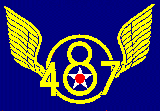 |
|
 |
|---|
A PIECE OF THE ACTION
by Bob Holliday (continued)Primary Training
Now we were getting somewhere. My next assignment was at a former commercial airport in Hemet, California, where we learned to fly in Ryan PT22 monoplanes. These had two open cockpits and wide, rugged landing gear for the benefit of kangarooing cadets. Our housing looked like a former airport motel and we even had a snack bar to supplement the excellent meals. They gave us helmets and goggles but there was only one white scarf to share for our official photos. The Commandant of Cadets was a First Lieutenant who rode around in a jeep with his Great Dane. It was still hot in August, and running five miles on blacktop wasn't my idea of fun.
The fun part was learning to fly those Ryans. We had civilian instructors-mine was Bob Chadwick who lived in Hemet. He was a natural pilot and reputed to be the only one who could make a PT22 do an Immelman (start a loop and at the top roll out to level flight). One day he was in a good mood and he showed me the Immelman. We also did some spins down between the clouds, probably illegal but satisfying. One day after I had logged about eight hours, he told me to take it up by myself. I soloed, always a big moment in the life of a young pilot.
I also learned to use some judgment. One day the runway was closed because of an accident. I was in the air at the time and, knowing that I only had fuel for about 30 minutes, I landed at an auxiliary field and waited. We had no radio communications so my instructor was a bit worried. Later, he congratulated me for doing the smart thing. We lost one cadet in my class and, as I was helping on the yearbook, it fell to me to write his obituary. I had some rosy ideas about life and death at that age, so I wrote something about him being at that snack bar in the sky. This did not go over well with some of the more conventional cadets, but not taking death too seriously stood me well later.
One thing I had trouble with was those pesky "pylon eights" where you had to put a wing down at just the right place and angle to pivot around an imaginary pylon. I still don't understand that maneuver but Mr. Chadwick was forgiving and passed me anyway.
Basic Training
In the Fall of 1943 I was sent to Gardner Field near Taft, California for Basic Training in BT13s. We were not far from Bakersfield and I was able to hitch a ride home that Christmas. The BT13 was more like a combat aircraft with a complete set of instruments. It had 450 horsepower but its landing gear was not retractable. Somebody said it flew like a barn door, especially in a spin, and spins were part of our routine training along with snaprolls, slow rolls, and loops. No Immelmans. We also learned to fly on instruments and at night, and we had our first taste of formation flying. All very heady stuff. Two incidents awakened me to the fact that even I had to keep my head on. On one night flight I misremembered my assigned altitude and almost plowed into a (fortunately) moonlit hill. Another night lesson involved takeoffs and landings under blackout conditions with nothing but smudgepots to mark the runway. Not only did I take off from a taxiway but the officer on the radio had to remind me that I was in high pitch. I managed to switch to low pitch (like low gear, more power) in time to get off the ground. I was never reprimanded for this—I guess they expected us to learn from our own mistakes—or become the subject of some dumb obituary.
Advanced Training
Then it was on to Stockton, California, to fly twin- engine Cessna AT17 Bobcats which were made of plywood, string, and fabric, or so it seemed. We didn't know it but we were all being trained to be copilots on heavy bombers. The Bobcats were fully equipped and instrumented but they were slow and landed at about 65 mph. There was a story about how some cadet flew low over a railroad track at night, with only one of his wing lights on, and scared the hell out of a locomotive engineer traveling toward him. Who knows? It could have happened.
The weather was spotty in Stockton so we flew down to Yuma, Arizona, for intensive flight training. We slept in tents wearing leather jackets with wool linings. It was much like being stationed somewhere overseas. One thing new: night cross- country flying by ourselves. There were always two of us so we got used to the pilot-copilot idea. Before we left Stockton we finished our ground school with classes lasting up to fourteen hours a day. Our training was getting more rigorous and some of cadets washed out to become navigators or bombardiers.
We graduated as Second Lieutenants and pilots in March 1944, the class of 44-C. On my first and only liberty in Stockton I was walking down the street when a group of Navy men saluted me, saying, "Good evening, Sir." This was the first time that I had been saluted and called Sir, so I got rattled and responded, "Good evening, Sir." That's the kind of thing you remember fondly.